
The livestock sector in Quirino Province continues to play a pivotal role in the region's agricultural economy, providing essential livelihoods for rural communities and contributing to food security. In the first quarter of 2025, the province has witnessed significant developments aimed at enhancing livestock production and sustainability.

In the first quarter of 2025, the livestock sector in Quirino Province exhibited mixed trends across various animal types in terms of production volume.
Carabao Production and Inventory
Carabao production for the 1st quarter 2025 increased to 90.24 metric tons, up from 81.65 metric tons (MT) in 2024 (Table 1, Figure 1). This growth is attributed to the rising demand both within and outside the province. Supporting this growth, the carabao inventory also showed a slight increase, reaching 21,333 heads as of March 31, 2025, compared to 21,300 heads in the same period of 2024 (Table 1, Figure 1). The expanded herd size has contributed to the higher production volume, ensuring a stable supply to meet market needs.
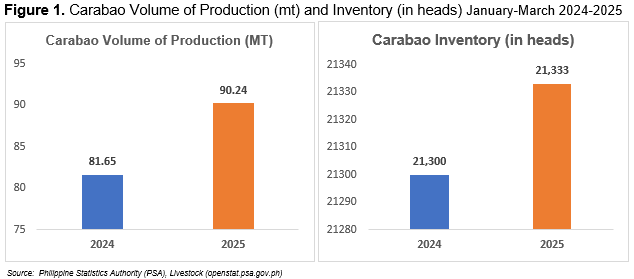
Cattle Production and Inventory
Cattle production dropped to 113.21 metric tons (MT) in the first quarter of 2025, down from 134.71 MT in 2024 (Table 1, Figure 1)., as fewer animals were available for slaughter. This decrease was primarily due to limited stocks available for slaughter, resulting from the continuous disposition of animals with lower live weight.
Correspondingly, the cattle inventoryas of March 31, 2025 dropped from 11,753 heads to 12,222 heads in the same period of 2024 (Table 1, Figure 2), reflecting the reduction in available animals for meat production.
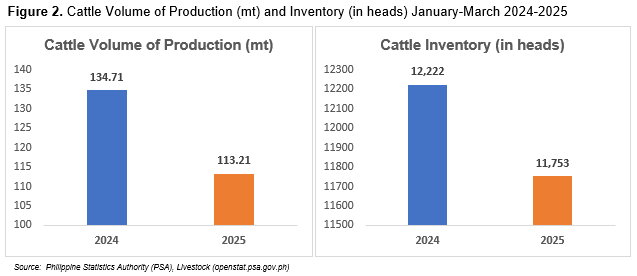
Swine Production and Inventory
Swine production showed a significant increase in the first quarter of 2025 to 597.05 metric tons (MT) from 466.05 metric tons (MT) in 2024 (Table 1, Figure 3). This growth is largely attributed to the availability of stocks ready for slaughter and the increasing demand from markets outside the province. Supporting this upward trend, the swine inventory grew substantially to 34,509 heads as of March 31, 2025 from 11,598 heads in the same period of 2024 (Table 1, Figure 3), indicating improved supply conditions and herd expansion efforts.
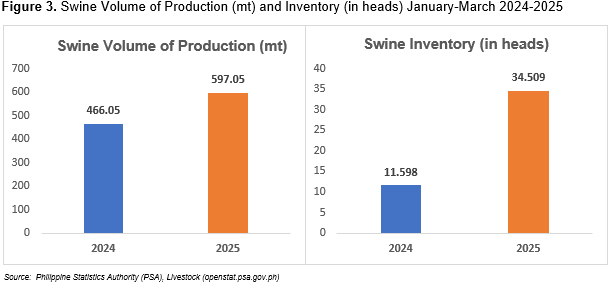
Goat Production and Inventory
Goat production increased to 32.39 metric tons in the first quarter of 2025, up from 29.94 metric tons in 2024 (Table 1, Figure 4). This growth was supported by a slight rise in inventory, which increased to 13,474 heads as of March 31, 2025, from 13,377 heads in the same period of 2024 (Table 1, Figure 4), indicating a stable supply of goats available for slaughter.
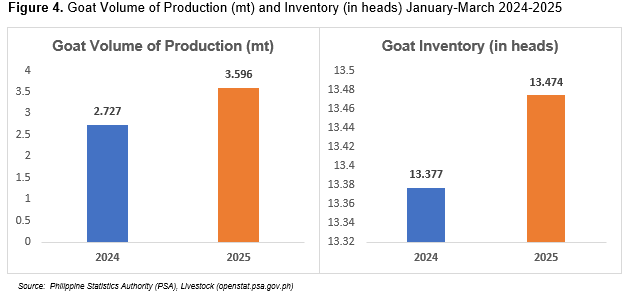
Sheep Production and Inventory
Sheep production increased significantly in the first quarter of 2025, rising to 1.36 metric tons from 0.09 metric tons in 2024 (Table 1, Figure 5). This growth was attributed to a higher number of slaughter-ready animals. Additionally, the sheep inventory rose to 3,596 heads as of March 31, 2025, up from 2,727 heads in the same period of 2024 (Table 1, Figure 5).
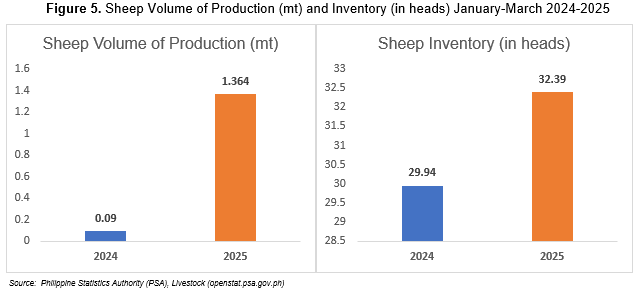
Definition of Terms
Animal Inventory (also Animal Population) – the actual number of animals (in head) present in the farm as of a specific reference date regardless of ownership.
Livestock – farm animals kept or raised for consumption and work. For purposes of census and surveys, livestock covers only those that are tended and raised by the household.
Carabao – a local term for water buffalo. It is a domesticated livestock characterized by its heavy built, low and wide body used in farms as draft animal and also suitable for milk production.
Cattle – a general term for domesticated bovine animals held as property or raised for use.
Goat – a domesticated hollow-horned ruminant mammal raised in farms.
Goat is locally termed as kambing, kalding, and kanding.
Sheep – an animal of Genus Ovis related to but stockier than goats.
Swine – a domesticated animal characterized by a stout body, short legs with a long mobile snout and is commonly known as pig. This includes foreign breed, domestic wild pigs (baboy damo), and native breeds such as Q-Black, Markaduke, Sinirangan, ISUbela, Benguet, and Yookah.
Volume of Production – the number of tended/raised animals disposed for slaughter/dressing including animals shipped-out for slaughter/dressing (in “head/bird” and in “liveweight equivalent”).
ENGR. CHERRY GRACE D. AGUSTIN
Chief Statistical Specialist
